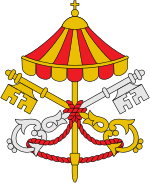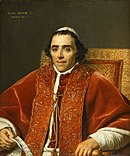Papal conclave, 1799–1800

Coat of arms during the vacancy of the Holy See
|
|
| Dates and location | |
|---|---|
| 30 November 1799 – 14 March 1800 San Giorgio Monastery, Venice, Archduchy of Austria |
|
| Key officials | |
| Dean | Gianfrancesco Albani |
| Camerlengo | Vacant functions administered by Romualdo Braschi-Onesti |
| Protopriest | Francesco Carafa della Spina di Traietto |
| Protodeacon | Antonmaria Doria-Pamphilj |
| Secretary | Ercole Consalvi |
| Elected Pope | |
|
Barnaba Niccolò Maria Luigi Chiaramonti (Name taken: Pius VII) |
|
 |
|
The Papal conclave of 1799–1800 followed the death of Pope Pius VI on 29 August 1799 and led to the selection as pope of Giorgio Barnaba Luigi Chiaramonti, who took the name Pius VII, on 14 March 1800. This conclave was held in Venice and was the last to take place outside Rome. This period was marked by uncertainty for the Pope and the Roman Catholic Church following the invasion of the Papal States and abduction of Pius VI under the French Directory.
Pius VI's reign had been marked by tension between his authority and that of the European monarchs and other institutions, both secular and ecclesiastical. This was largely due to his moderate liberal and reforming pretences. At the beginning of his pontificate he promised to continue the work of his predecessor, Pope Clement XIV, in whose 1773 brief Dominus ac Redemptor, the dissolution of the Jesuits was announced. Pro-Jesuit powers remained in support of Pius, thinking him secretly more inclined to the Society than Clement. The Archduchy of Austria proved a threat when its ruler, Emperor Joseph II, made internal reforms which conflicted with some of the power of the Papacy. Further, German archbishops had shown independence at the 1786 Congress of Ems, but were soon brought into line.
At the outbreak of the French Revolution Pius was compelled to see the independent Gallican Church suppressed, the pontifical and ecclesiastical possessions in France confiscated and an effigy of himself burnt by the populace at the Palais Royal. The murder of the republican agent Hugo Basseville in the streets of Rome (January 1793) gave new ground of offence; the papal court was charged with complicity by the French Convention, and Pius threw in his lot with the First Coalition against the French First Republic.
...
Wikipedia
